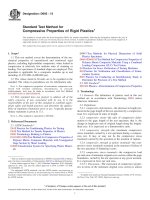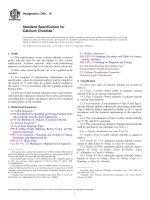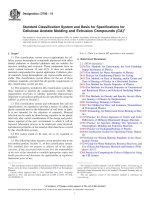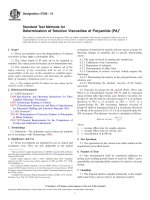Astm d 1386 15
Bạn đang xem bản rút gọn của tài liệu. Xem và tải ngay bản đầy đủ của tài liệu tại đây (64.55 KB, 2 trang )
Designation: D1386 − 15
Standard Test Method for
Acid Number (Empirical) of Synthetic and Natural Waxes1
This standard is issued under the fixed designation D1386; the number immediately following the designation indicates the year of
original adoption or, in the case of revision, the year of last revision. A number in parentheses indicates the year of last reapproval. A
superscript epsilon (´) indicates an editorial change since the last revision or reapproval.
This standard has been approved for use by agencies of the U.S. Department of Defense.
5. Apparatus
1. Scope
1.1 This test method covers the determination of the acid
number of synthetic waxes and natural waxes. The number is
obtained by direct titration of the material and indicates the
amount of free acid present.
5.1 Analytical Balance.
5.2 Buret, 50-mL, with 0.1-mL graduations.
5.3 Flasks, acid value, 250-mL.
1.2 This test method, using an ethanol-xylene mixture, is
applicable to all natural waxes, including carnauba. The test
method is also applicable to oxidized microcrystalline waxes,
oxidized Fischer-Tropsch, oxidized polyethylene, and montan
esters.
6. Reagents and Materials
6.1 Purity of Reagents—Reagent-grade chemicals or
equivalent, as specified in Practice E200, shall be used in all
tests.
1.3 The values stated in SI units are to be regarded as
standard. No other units of measurement are included in this
standard.
1.4 This standard does not purport to address all of the
safety concerns, if any, associated with its use. It is the
responsibility of the user of this standard to establish appropriate safety and health practices and determine the applicability of regulatory limitations prior to use.
6.2 Ethanolic Potassium Hydroxide, Standard Solution—
Dissolve approximately 5.6 g of potassium hydroxide in 5.6 g
of distilled water. Dilute with USSD3A denatured ethanol or
95 % ethanol to 1000 mL. Standardize with 0.1 N hydrochloric
acid.
6.3 Phenolphthalein Indicator Solution (10 g/litre)—
Dissolve 1 g of phenolphthalein in 100 mL of USSD3A,
denatured ethanol or 95 % ethanol.
2. Referenced Document
6.4 Xylene.
2.1 ASTM Standards:2
E200 Practice for Preparation, Standardization, and Storage
of Standard and Reagent Solutions for Chemical Analysis
7. Procedure
7.1 Transfer 1 to 2 g of the sample, weighed to the nearest
0.001 g, to a 250-mL acid-value flask. Add 40 mL of xylene.
Heat on a hot plate or water bath to put the sample into
solution. Occasional swirling may be necessary.
3. Terminology
3.1 Definitions:
3.1.1 acid number or acid value—the number of milligrams
of potassium hydroxide necessary to neutralize 1 g of the
sample.
7.2 Add 3 to 5 drops of phenolphthalein indicator solution
and titrate the hot solution to the first persistent pink color. The
end point is taken when the pink color remains for at least 10 s.
Swirl the flask vigorously during the titration. If precipitation
of waxes occurs during titration, reheat the sample. The
titration should be carried out as quickly as possible. Record
the number of millilitres of standard alkali solution used.
Warning—To avoid saponification, do not reheat the solution
during this operation.
4. Significance and Use
4.1 This test method is used to determine the property of
acid functionality. Acid functionality determines the utility of
the wax as well as being a significant Quality Control test.
1
This test method is under the jurisdiction of ASTM Committee D21 on Polishes
and is the direct responsibility of Subcommittee D21.02 on Raw Materials.
Current edition approved Oct. 1, 2015. Published October 2015. Originally
approved in 1955 as D1386 – 55 T. Last previous edition approved in 2010 as
D1386 – 10. DOI: 10.1520/D1386-15.
2
For referenced ASTM standards, visit the ASTM website, www.astm.org, or
contact ASTM Customer Service at For Annual Book of ASTM
Standards volume information, refer to the standard’s Document Summary page on
the ASTM website.
7.3 Determine the blank titration value by repeating the
procedure of 7.1 and 7.2 without the addition of sample
material.
7.4 Run a total of three titrations of sample being tested and
one blank.
Copyright © ASTM International, 100 Barr Harbor Drive, PO Box C700, West Conshohocken, PA 19428-2959. United States
1
D1386 − 15
9. Precision and Bias
8. Calculation
8.1 Calculate the acid number as follows:
9.1 Precision—Duplicate results by the same operator shall
not be considered suspect unless the results are greater than a
standard deviation of 0.8.
Acid number 5 ~ A 2 B ! 3 N 3 ~ 56.1! /C
9.2 Bias—This test has no bias because the values produced
are defined only in terms of this test method.
A = millilitres of alkali solution required for titration of the
sample,
B = millilitres of alkali solution required for titration of the
blank sample,
N = normality of the alkali solution, and
C = grams of sample used.
10. Keywords
10.1 acid number; free acid; natural waxes; polish; synthetic
waxes; titration; waxes
ASTM International takes no position respecting the validity of any patent rights asserted in connection with any item mentioned
in this standard. Users of this standard are expressly advised that determination of the validity of any such patent rights, and the risk
of infringement of such rights, are entirely their own responsibility.
This standard is subject to revision at any time by the responsible technical committee and must be reviewed every five years and
if not revised, either reapproved or withdrawn. Your comments are invited either for revision of this standard or for additional standards
and should be addressed to ASTM International Headquarters. Your comments will receive careful consideration at a meeting of the
responsible technical committee, which you may attend. If you feel that your comments have not received a fair hearing you should
make your views known to the ASTM Committee on Standards, at the address shown below.
This standard is copyrighted by ASTM International, 100 Barr Harbor Drive, PO Box C700, West Conshohocken, PA 19428-2959,
United States. Individual reprints (single or multiple copies) of this standard may be obtained by contacting ASTM at the above
address or at 610-832-9585 (phone), 610-832-9555 (fax), or (e-mail); or through the ASTM website
(www.astm.org). Permission rights to photocopy the standard may also be secured from the Copyright Clearance Center, 222
Rosewood Drive, Danvers, MA 01923, Tel: (978) 646-2600; />
2









